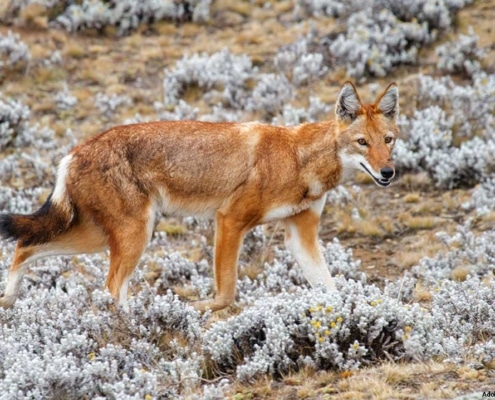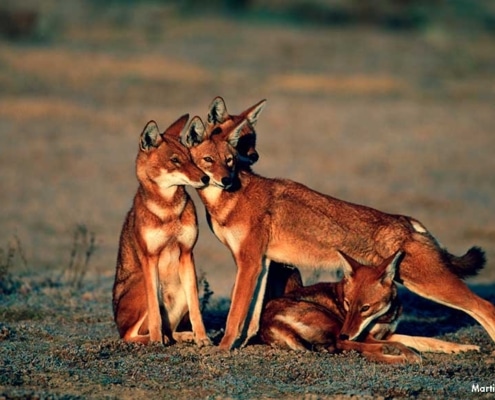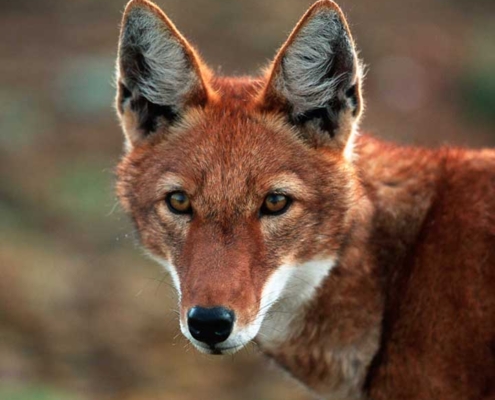Select a Location
Ethiopia at a Glance
Is the Ethiopian wolf a real wolf? Or is it just a canid whose common name happens to include “wolf” like the maned wolf of South America (Chrysocyon brachyurus)?
Biologists agree that the Ethiopian wolf at least belongs to the genus Canis, with its scientific name, Canis simensis. That designation thus includes the Ethiopian wolf with the gray wolf (Canis lupus), the red wolf (Canis rufus), but also with the coyote (Canis latrans) and jackals, for example the former golden jackal (Canis aureus), now called the African wolf.
Both Canis simensis and Canis aureus inhabit Ethiopia, and geneticists consider both to be similar to the gray wolf. Gottelli et al. (1994) stated: “Our results suggest that the Ethiopian wolf is a distinct species more closely related to gray wolves and coyotes than to any African canid.” Rueness et al. (2011) stated: “The Egyptian jackal (Canis aureus lupaster) has hitherto been considered a large, rare subspecies of the golden jackal (C. aureus).” . . . “Through phylogenetic comparison with all wild wolf-like canids (based on 726 bp of the Cytochrome b gene) we conclusively (100% bootstrap support) place the Egyptian jackal within the grey wolf species complex . . . .” “We thus refer to C. a. lupaster as the African wolf. Furthermore, we have detected C. a. lupaster individuals at two localities in the Ethiopian highlands, extending the distribution by at least 2,500 km southeast.” More recently, Krofel et al. (2021) who synthesized genetic evidence of various canids assessed the genetic exchange among them: “Using several analytical methods to detect signals of historical admixture among species, these authors [Gopalakrishnan et al., 2018] found evidence of gene flow among the ancestors and lineages of the golden jackal, African wolf, grey wolf and Ethiopian wolf (Canis simensis).”
Thus, whether the Ethiopian wolf (Canis simensis) is a real wolf seems to be a matter of what is considered a “real wolf,” and biologists do not appear to be in agreement on this. Generally scientists agree that the gray wolf (Canis lupus) and the red wolf (Canis rufus) are wolves but do not consider the coyote (Canis latrans) or the black-backed jackal (Canis mesomelas) wolves. For now, what the Ethiopian wolf is an open question.
References
Gottelli, D., C. Sillero-Zubiri, G. D. Applebaum, M. S. Roy, D. J. Girman, J. Garcia-Moreno, E. A. Ostrander, R. K. Wayne. 1994. Molecular genetics of the most endangered canid: the Ethiopian wolf Canis simensis. Molecular Ecology 3: 301-312. https://doi.org/10.1111/j.1365-294X.1994.tb00070.x
Rueness, E. K., Asmyhr, M. G., Sillero-Zubiri, C., Macdonald, D.W., Bekele, A., Atickem, A., & Stenseth, N. C. 2011. The Cryptic African Wolf: Canis aureus lupaster is not a Golden Jackal and is not endemic to Egypt. PLoS One, 6, e16385
Krofel, M., J. Hatlauf, W. Bogdanowicz, L. A. D. Campbell, R. Godinho, Y. V. Jhala, A. C. Kitchener, K.-P. Koepfli, P. Moehlman, H. Senn, C. Sillero-Zubiri, S. Viranta, G. Werhahn, F. Alvares. 2021. Towards resolving taxonomic uncertainties in wolf, dog and jackal lineages of Africa, Eurasia and Australasia. J. Zoology 316: 155-168. https://doi.org/10.1111/jzo.12946
Species Information
Species
Common Names: Ethiopian wolf, Abyssinian wolf, ky kebero (Amharic for “red jackal), jedalla farda (Oromo), Simien jackal
Latin Name: Canis simensis
Current Population, Trend, Status
Number of wolves: Fewer than 440, according to the African Wildlife Foundation
Population trend: Decreasing
Legal protection: Full protection
Related News
Africa’s Lone Wolf: New Species Found in Ethiopia
This page was last updated in 2020.
Human Relationships
Recovery and Management
- Article: Endangered Means There’s Still Time
- Article: Threat to Recovery: Rabies
Related Links and Information
- Wildlife Conservation Research Unit (One of the most comprehensive sites on the Ethiopian wolf.)
- Ethiopian Wolf Conservation Programme
- How oral vaccines could save Ethiopian wolves from extinction
- Battling to save the Ethiopian wolf, Africa’s rarest carnivore
- Large carnivores have lost more than 90 percent of their range
- Last 500 Ethiopian wolves endangered by lack of genetic diversity
- World’s large carnivores being pushed off the map
Ecology
Canis Simensis Biology
The Ethiopian wolf (C. simensis), once thought to be closely related to the jackal, is actually more closely related to the gray wolf and coyote than any African canid. This conclusion was reached through phylogenetic analysis using mitochondrial DNA sequencing. It is thought that this species evolved from a gray wolf-like ancestor that crossed Eurasia to northern Africa as recently as 100,000 years ago.
This medium sized canid has a reddish coat, distinctive white markings throughout the body and black markings on the tail, long legs and an elongated muzzle. The contrast of white markings against the red coat increases with age and social rank in both sexes. Males are significantly larger (20%) than females with an average weight of 16.2 kg (14.2 – 19.3 kg) females weigh an average of 12.8 kg (11.2 – 14.15 kg).
Ethiopian wolves are endemic to the Ethiopian highlands, above the tree line at about 3,200m. The only records of these wolves below 3,000m were specimens collected at 2,500m from Gojjam and north-western Shoa (north-west and central Ethiopia) at the beginning of the century. Currently, Ethiopian wolves are confined to seven isolated mountain ranges of the Ethiopian highlands
Over half of the species’ population live in the Bale Mountains where two core areas for recovery are located: the Web Valley and the Sanetti Plateau.
The habitat of these wolves is confined to Afro-alpine grasslands and heathlands at about 3,200m-4,500m where they prey on Afroalpine rodents. Subsistence agriculture reaches up to 3,500-3,800m in many areas and often restricts wolves to higher ranges. A pronounced dry season goes from December to February/March.
Wolves prefer flat or gently sloping open areas with low vegetation, deep soils and poor drainage in parts where rodents are most abundant. Rodents account for 96% of all prey occurrences in Ethiopian wolf scat. Eighty seven percent of the rodents consumed consist of three main species: the giant molerat, Blick’s grass rat and the black-clawed brush-furred rat. Other prey include typical vlei rat, yellow spotted brush-furred rat, Starck’s hare, and goslings and eggs, rock hyrax, young common duiker, reedbuck and mountain nyala. Sedge leaves are occasionally ingested believed to help with digestion or parasite control.
Depredation is an issue with the Ethiopian wolf as it is with other wolf species. However, Ethiopian wolves present a lesser danger compared to hyenas and jackals with the occurrence of livestock remains in wolf scat uncommon across the highlands.
Social interactions and communication between Ethiopian wolves is similar to other wolf species with an average pack size of 3-13 individuals. However, males rarely disperse and are instead recruited into multi-male philopatric packs. Sexually mature females are the main dispersers and have strictly limited movements for lack of habitat. These females look for openings in packs, often packs with deceased breeding females. Average pack territory is 6.0-13.2 square km with some overlapping ranges. Females may accept courting from males within the pack or neighboring packs. Preference is shown to the dominant male in the pack although, studies have found that 70% of matings involved males from outside the pack. Breeding season is usually anytime from August through November. During breeding and pregnancy, the female’s coat changes to pale yellow and becomes woolly while the tail turns brownish and loses hair. Two to seven young are born in October through January, blind and deaf with a charcoal gray natal coat that has a buff patch in the chest and groin areas. Full, adult appearance is reached at two years as is sexual maturity. Life span in the wild is approximately eight to ten years.
Natural causes of mortality include predation of young by spotted hyenas or raptors, starvation in juveniles occurring more frequently with females, pathogens and parasites such as rabies which is the main cause in Bale, and human causes.
The Ethiopian wolf is considered a critically rare canid and one of the rarest African carnivores. Population decline is a result of many factors: continuous loss of habitat due to agriculture (sustenance farming and overgrazing), traffic incidents and shootings, hybridization with domestic dogs, and disease. The Ethiopian wolf receives full official protection under Ethiopia’s Wildlife Conservation Regulations of 1974, Schedule VI. Killing of a wolf carries a sentence of up to two years imprisonment.
Conservation efforts include vaccination of both domestic dogs and wild wolves from rabies, sterilization of domestic dogs and hybrids, funding patrolling and maintenance of recovery areas, surveys and monitoring of populations, workshops to educate about Ethiopian wolves, the Bale Mountains Research Project begun in 1983, and the establishment of the Ethiopian Wolf Conservation Programme (EWCP) in 1995. There are no Ethiopian wolves in captivity.
For more information, visit the EWCP Website or download their annual report.




